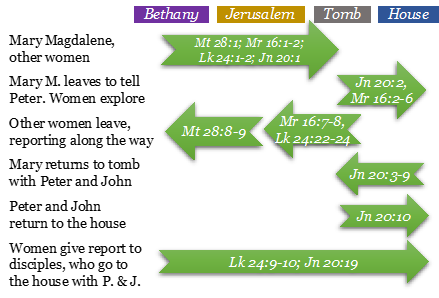If any miracle of the Bible is going to attract the critics, the resurrection of Jesus from Joseph of Arimathea’s new tomb after three days is a prime target. After all, Jesus’ resurrection is the uniquely premier event of all human history. For believer and unbeliever alike, it validates His words like nothing else can. It assures believers of their justification, regeneration and future resurrection as well. But to be honest, reconstructing the events on that glorious day is challenging due to a common narrative approach used by historians. They “telescope” information; meaning, some details are skipped to focus on key points (from their perspective). All gospel authors appear to use this technique.
Some of the challenges in harmonizing the gospel accounts lie in the following areas: How many women went to the tomb, and when did they leave? When and where did they see Jesus? Was the tomb already open? How many angels appeared? This article is helped by Mr. Tim Chaffy who wrote a book, In The Defense of Easter: Answering Critical Challenges to the Resurrection of Jesus,[1] which provides some helpful observations and reasonable assumptions to make all the data plausibly fit.
First, it’s clear that multiple women first went to the tomb, early in the morning. Mary Magdalene is particularly called out in three gospels. Luke names three women and says other women also went; thus, there are at least five who went. John only mentions Mary, but she told Peter they have taken away the Lord out of the sepulchre, and we know not where they have laid him. John is telescoped on Mary. No conflicts seen here.
Mark, Luke and John all indicate the stone was already rolled away, but Matthew’s wording appears to differ: behold, there was a great earthquake: for the angel of the Lord descended from heaven, and came and rolled back the stone from the door, and sat upon it. Matthew’s account isn’t a contradiction; he’s only reporting what already happened. Similarly, Matthew and Mark telescope to only focus on one angel, whereas Luke and John mention the two angels that are present.
The order of appearances is more challenging. Matthew has the women visiting the tomb, see an angel, run to tell the disciples, then see Jesus on their way. Mark is explicit, however, that He appeared first to Mary Magdalene, and then, only after her return to the tomb with Peter and John. How can both be true? Why wouldn’t these women have crossed paths on their way?
One reasonable assumption to make is that Peter and John, who followed Jesus to His trial in Jerusalem, returned to a different house afterwards, not to where all the other scattered disciples re-grouped, which likely was at Martha and Mary’s home in Bethany. This helps explain the timing of the sightings, as well as providing two different routes for the women. Mr. Chaffy’s harmony of the resurrection day events is depicted in the graphic (below).

If the other disciples fled to Martha and Mary’s house in Bethany where Jesus often stayed on trips to Jerusalem, then the difficulties resolve nicely. Mary Magdalene would have left before the other women explored the tomb and saw the angels. After they leave, Mary Magdalene returns with Peter and John (who leave shortly afterward) and sees Jesus first. The other women see Him on the way, report this to Clopas (Lk 24:22-24), and then to the other disciples. They all eventually wind up in the house where Peter and John were at. What a glorious and chaotic day that must have been!
[1] Watch an animated depiction at https://answersingenesis.org/jesus/resurrection/christs-resurrection-four-accounts-one-reality/
Like this? Consider sharing it to Facebook by clicking the linked icon below.
